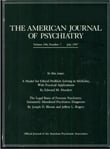METHOD
A survey of all psychiatric patients (N=1,744) from Kuopio University Hospital in eastern Finland was carried out in 1993. Only those patients for whom an assessment had been made both by the patients themselves and by hospital personnel and for whom both smoking and suicide data were complete were included in the analyses (N=1,217). The response rate was moderate (70%). The nonrespondents did not differ from the respondents with regard to suicidal tendency (
12). The procedures in the study were approved according to the appropriate institutional guidelines. After complete description of the study to the subjects, written informed consent was obtained.
Diagnoses were based on DSM-III-R criteria and were made by psychiatrists. Sex, age, marital status, education, employment status, and income level were recorded. Those who consumed alcohol at least on a weekly basis were classified as regular drinkers. Current smokers were identified as those who smoked at least one cigarette per day.
The level of depression was evaluated with the 13-item Beck Depression Inventory (
13). Those with scores of 16 or higher were classified as severely depressed. The number of previous suicide attempts was checked from the hospital records (0=none, 1=one or more attempts), and suicidal ideation was assessed by the staff (0=not at all, 1=mild or severe).
Associations between categorical variables were estimated by the chi-square test with continuity (Yates's) correction. In the multiple logistic regression analyses, the forward stepwise method was used.
RESULTS
The mean age of the 1,217 respondents was 41.0 years (SD=13.9). Fifty-six percent (N=676) were women, 66% (N=803) were not married, 26% (N=312) had a low level of basic education, 38% (N=466) had a low level of income, and 84% (N=1,017) were out of work. Schizophrenia was the main psychiatric diagnosis (33%, N=403), followed by major affective disorder (29%, N=349), personality disorder (11%, N=131), dysthymia (8%, N=96), and anxiety disorder (8%, N=100). Since the group of patients with other psychiatric disorders (11%, N=138) was considered to be too heterogeneous, it was excluded from the analysis.
Twenty-four percent (N=125 of 527) of the men and 26% (N=167 of 655) of the women had attempted suicide at least once. The rate of previous suicide attempts was significantly higher for current smokers than for nonsmokers both for men (29% versus 16%, respectively; χ²=9.80, df=1, p=0.002) and women (35% versus 20% χ²=18.94, df=1, p=0.00001).
Suicidal ideation was present in 31% (N=166 of 530) of the male patients and 22% (N=142 of 658) of the female patients. The rate was significantly different between smokers and nonsmokers for male patients (35% versus 25% χ²=5.69, df=1, p=0.02) but not for female patients (25% versus 19% χ²=3.08, df=1, p=0.08).
We performed two multiple logistic regression analyses (N=1,044) to estimate adjusted odds ratios with 95% confidence intervals for current smoking and other possible predictors: sex, age, marital status, education, income level, employment status, psychiatric diagnosis (five dummy variables), alcohol drinking habit, and level of depression. Previous suicide attempts (regression I) and current suicidal ideation (regression II) were the dependent variables.
In regression I, severe depression (adjusted odds ratio=2.53, 95% confidence interval=1.86–3.45, p<0.0001), current smoking (adjusted odds ratio=2.00, 95% confidence interval=1.48–2.70, p<0.0001), male gender (adjusted odds ratio=1.57, 95% confidence interval=1.16–2.13, p=0.004), and anxiety disorder (adjusted odds ratio=0.51, 95% confidence interval=0.28–0.96, p=0.04) were associated with previous suicide attempts and entered the model in this order as significant predictors. The entire logistic model correctly classified 75.2% of the cases.
In regression II, 75.5% of the cases were correctly classified by the variables in the regression equation. Severe depression (adjusted odds ratio=3.81, 95% confidence interval=2.80–5.18, p<0.0001), schizophrenia (adjusted odds ratio=0.56, 95% confidence interval=0.38–0.82, p=0.003), female gender (adjusted odds ratio=0.71, 95% confidence interval=0.53–0.96, p=0.03), current smoking (adjusted odds ratio=1.43, 95% confidence interval=1.05–1.93, p=0.02), and major affective disorder (adjusted odds ratio=1.45, 95% confidence interval=1.03–2.04, p=0.03) were associated with suicidal ideation and entered the model.
DISCUSSION
This is the first survey, to our knowledge, to demonstrate the positive relationship between smoking and suicidality in psychiatric patients. This association remained statistically significant after we controlled for several potential confounding factors. However, this could also be explained by some other factors—for example, psychological stress (
14) or alcoholism (
15). At this stage, we are cautious about declaring any independence of this association (
10) before certain questions on the interpretation of epidemiological studies have been answered (
16).
The assessments in this study were based on the opinions of staff and patients and are therefore dependent on their assessment capabilities. However, the fact that several people were involved in the assessment process makes it more reliable. In addition, the patients completed the questionnaire anonymously, so they were not tempted to bias their responses to please the staff.
Could depression be the “third factor” linking smoking to suicidal behavior? It is known that nicotine use can provoke depression (
11), but, on the other hand, people with depressive symptoms find nicotine an efficient self-medication, and in some individuals, nicotine may act as an antidepressant (
17).
Nicotine meets all criteria of a highly addictive drug that has the poorest success rate for cessation (
18). As social attitudes and public health policy interact to diminish the rate of smoking in the general population and in psychiatric hospitals, the remaining smokers will be those most severely addicted. In Finland, the suicide rate among men is one of the highest in the world and has doubled during the last few decades. There is a clear need for specially tailored interventions for both smoking cessation and lowering the risk of suicide, and in the future more resources should be targeted to solve these important problems.

